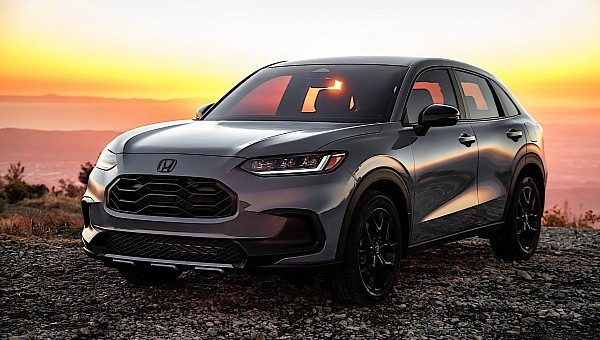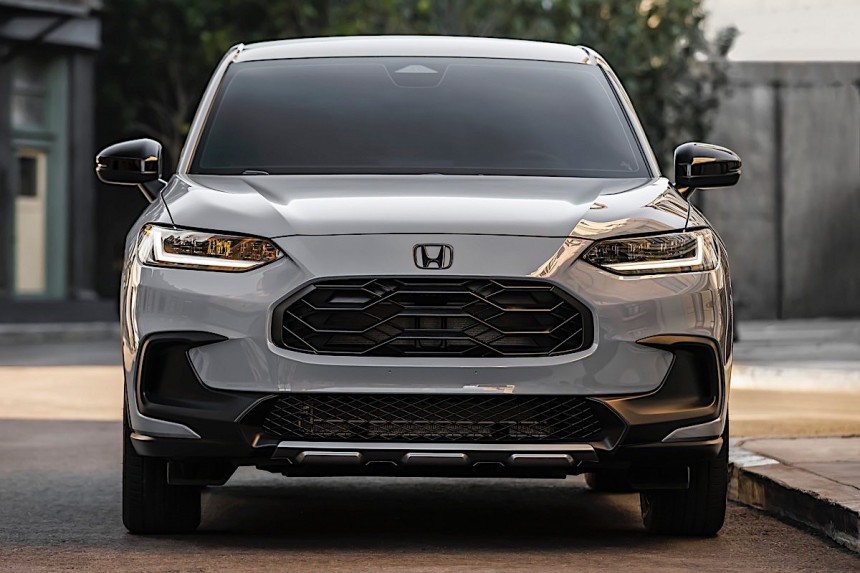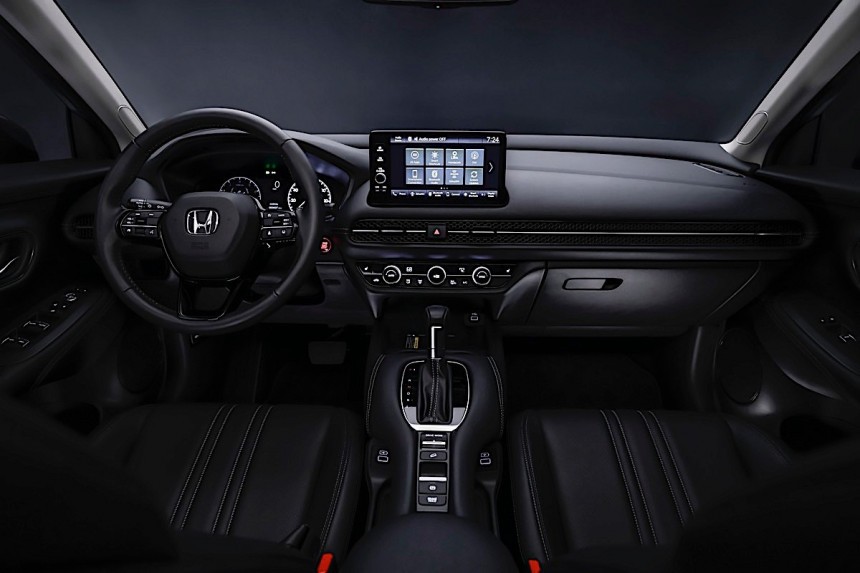Driven: 2023 Honda HR-V Grows Up
If you want to understand the concept of mission creep, all you need to do is look at the current crop of subcompact SUVs. In each succeeding generation, these vehicles get larger, and their sticker prices go up. It’s not necessarily a bad thing as the 2023 Honda HR-V demonstrates.
Previously based on the now-discontinued Fit subcompact, the latest HR-V has a new platform and has grown to the point to where it could be confused with an earlier generation CR-V. The new model rides on a 104.5-inch (265.4 cm) wheelbase, up nearly two inches over the previous model. Overall length has grown by nearly 10 inches to 179.8 (456.6 cm), while at 72.4 inches (183.8 cm) in width, it’s expanded 3.4 inches across the beam.
To go along with these more substantial dimensions, the HR-V also has bolder SUV styling. The more muscular exterior features a new trapezoidal mesh grille design that looks like it came from a Ford product. Traditional SUV cues like wheel arch extensions, rocker sills and dark front and rear fascia panels along with a hatch-topping spoiler give the HR-V a totally new look.
The drivetrain has also been beefed up increasing the 4-cylinder engine’s displacement from 1.8 to 2.0 liters which results in more output. The HR-V now makes 158 horsepower and 138 lb-ft of torque, respective bumps of 17 horses and 11 twist units. The transmission in both front- and all-wheel drive models remains a continuously variable transmission.
The larger HR-V tips the scales at 3,159 pounds, about 250 pounds more than the previous model. As a result of more weight and extra engine power, fuel economy dips a bit to 26 mpg city/32 mpg (9/7.3 liters per 100 km) highway for 28 mpg (8.4 liters per 100 km) combined in front-drive, down two mpg across the board from the previous model. For 2023, AWD HR-Vs are rated at 25 mpg city/30 mpg (9.4/7.8 liters per 100 km) highway for a combined 27 mpg (8.7 liters per 100 km).
The resulting driving experience is an HR-V that feels much more substantial than the vehicle it replaces. The new model is quieter, a bit more composed with a smoother ride thanks to the longer wheelbase and wider track. Steering remains light and responsive, and the brakes linear and solid in application. The CVT seems more responsive, there’s less of a rubber band feel to the drivetrain on hard acceleration. The HR-V has moved up from being a somewhat tinny subcompact crossover to a more substantial compact SUV.
The biggest noticeable change, however, is the interior itself. It is well-executed with plenty of soft-touch surfaces. In fact, the cabin comes off as being a touch more luxe than the all-new CR-V. The base LX and step-up Sport models have seven-inch touchscreens while the range-topping EX-L boasts a nine-inch infotainment display. The front seats are comfortable and supportive and thanks to the larger overall footprint of the vehicle, it’s a legit five-passenger ride.
The dash layout is conventional with traditional analog gauges beneath a binnacle in front the driver. There are switches and knobs on the steering wheel, center console and on the dash to operate most of the vehicle’s systems and the gear selector remains a shift lever. The touchscreen is used to access infotainment features and all models come with Apple CarPlay and Android Auto connectivity.
Perhaps the only downside to the new, larger HR-V is that the previous generation’s second-row Magic Seat has been given the heave-ho. This multi-adjustable, fold-flat seat provided the previous HR-V with a high level of utility. As a result, the new HR-V doesn’t really offer that much more in the way of usable storage space with its conventional split-fold-down rear seats.
The new model provides 24.4 cubic feet of storage space behind the rear row that expands to 55.1 cubic feet with the back seat stowed. The previous HR-V had 24.3 cubic feet behind the back seat and could expand up to 58.8 cubic feet in some models. Still, that slight lack in cargo space is more than compensated by the roomier and more nicely trimmed cabin on the new version.
All models come with standard safety assists including forward collision and lane departure warnings, collision mitigation braking and road departure mitigation. Other standard items include adaptive cruise control with low-speed follow, traffic sign recognition, lane-keeping assist, and a rear seat reminder. The Sport and EX-L benefit from standard blind spot alerts with a cross-traffic monitor.
With such a major upgrade in the overall package, you’d expect a big jump in prices, but happily the window sticker for the 2023 Honda HR-V base LX model starts at $23,650, about an $1,800 bump over last year. All-wheel drive will add another $1,500. An even better value is springing for the top line HR-V EX-L with all-wheel drive. Starting at $28,950 plus $1,245 destination, it costs only $800 more than a comparably equipped 2022 model.
While we may miss the innovative Magic Seat of the previous model, the bigger and better Honda HR-V remains a benchmark among small SUVs.
To go along with these more substantial dimensions, the HR-V also has bolder SUV styling. The more muscular exterior features a new trapezoidal mesh grille design that looks like it came from a Ford product. Traditional SUV cues like wheel arch extensions, rocker sills and dark front and rear fascia panels along with a hatch-topping spoiler give the HR-V a totally new look.
The drivetrain has also been beefed up increasing the 4-cylinder engine’s displacement from 1.8 to 2.0 liters which results in more output. The HR-V now makes 158 horsepower and 138 lb-ft of torque, respective bumps of 17 horses and 11 twist units. The transmission in both front- and all-wheel drive models remains a continuously variable transmission.
The larger HR-V tips the scales at 3,159 pounds, about 250 pounds more than the previous model. As a result of more weight and extra engine power, fuel economy dips a bit to 26 mpg city/32 mpg (9/7.3 liters per 100 km) highway for 28 mpg (8.4 liters per 100 km) combined in front-drive, down two mpg across the board from the previous model. For 2023, AWD HR-Vs are rated at 25 mpg city/30 mpg (9.4/7.8 liters per 100 km) highway for a combined 27 mpg (8.7 liters per 100 km).
The biggest noticeable change, however, is the interior itself. It is well-executed with plenty of soft-touch surfaces. In fact, the cabin comes off as being a touch more luxe than the all-new CR-V. The base LX and step-up Sport models have seven-inch touchscreens while the range-topping EX-L boasts a nine-inch infotainment display. The front seats are comfortable and supportive and thanks to the larger overall footprint of the vehicle, it’s a legit five-passenger ride.
The dash layout is conventional with traditional analog gauges beneath a binnacle in front the driver. There are switches and knobs on the steering wheel, center console and on the dash to operate most of the vehicle’s systems and the gear selector remains a shift lever. The touchscreen is used to access infotainment features and all models come with Apple CarPlay and Android Auto connectivity.
Perhaps the only downside to the new, larger HR-V is that the previous generation’s second-row Magic Seat has been given the heave-ho. This multi-adjustable, fold-flat seat provided the previous HR-V with a high level of utility. As a result, the new HR-V doesn’t really offer that much more in the way of usable storage space with its conventional split-fold-down rear seats.
All models come with standard safety assists including forward collision and lane departure warnings, collision mitigation braking and road departure mitigation. Other standard items include adaptive cruise control with low-speed follow, traffic sign recognition, lane-keeping assist, and a rear seat reminder. The Sport and EX-L benefit from standard blind spot alerts with a cross-traffic monitor.
With such a major upgrade in the overall package, you’d expect a big jump in prices, but happily the window sticker for the 2023 Honda HR-V base LX model starts at $23,650, about an $1,800 bump over last year. All-wheel drive will add another $1,500. An even better value is springing for the top line HR-V EX-L with all-wheel drive. Starting at $28,950 plus $1,245 destination, it costs only $800 more than a comparably equipped 2022 model.
While we may miss the innovative Magic Seat of the previous model, the bigger and better Honda HR-V remains a benchmark among small SUVs.








































